Understanding Meat Thawing Boards: Science & Benefits
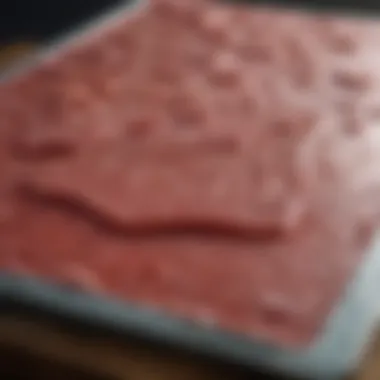

Intro
The process of thawing meat often presents a dilemma for many home cooks and culinary enthusiasts. Proper thawing not only affects the flavor and texture of meat, but also holds significant implications for food safety. Among the various methods available, the use of specialized meat thawing boards has gained attention. These boards claim to accelerate the thawing process while ensuring that meat remains safe to handle. This article will explore the scientific principles underpinning meat thawing, assess the performance of thawing boards compared to traditional methods, and consider hygiene and maintenance practices related to their use.
Understanding the science behind thawing meat is crucial. The core of this practice involves heat transfer, where warmer air or surfaces cause ice within the meat to melt. Various factors, including the shape, thickness, and initial temperature of the meat, influence the thawing rate. Knowing these principles can lead to better decision-making in the kitchen.
In addition to thermal dynamics, hygiene is another essential aspect. Handling thawed meat improperly can introduce harmful bacteria, leading to foodborne illnesses. Thus, understanding how to maintain cleanliness while using thawing boards is critical.
This article will not only address the effectiveness of thawing boards but also dissect the overall implications of defrosting on culinary practices. We aim to provide insights that are valuable for food lovers of all ages, enhancing both the safety and quality of meat preparation.
Prologue to Meat Thawing Boards
The act of thawing meat is a crucial step in the preparation of many dishes. Proper thawing affects not just texture and flavor but also food safety. In this article, we will examine the specific role of meat thawing boards and their significance in this process. These specialized boards have gained attention for their efficiency in thawing compared to more traditional methods, which can lead to uneven heating and foodborne illness if done improperly.
A thawing board not only expedites the thawing of frozen meat but also holds certain advantages that other methods lack. For instance, using a thawing board can help maintain the integrity of the meat while ensuring it thaws uniformly. This can be pivotal for achieving optimal results in cooking, thereby enhancing the overall dining experience.
Understanding the Need for Thawing
Thawing meat serves essential purposes. First, it brings frozen protein to a suitable temperature for cooking. This is important for safety, as cooking meat from a frozen state can lead to uneven cooking, where some parts may not reach the required internal temperature. Also, thawing allows the meat to absorb seasonings and marinades better, thus enhancing flavor.
Inadequate thawing methods, such as leaving meat out at room temperature, can lead to the growth of harmful bacteria. Selecting a proper thawing method, therefore, is critical for health and culinary success.
An Overview of Thawing Boards
Thawing boards are designed with specific materials and surfaces that promote the efficient transfer of heat, allowing for faster thawing. They come in various types, each with unique properties that cater to different needs. For example, some boards are made from aluminum or other metal compounds known for their excellent thermal conductivity, while others may use non-stick materials for added convenience.
Furthermore, the design of these boards often includes elements to enhance usability, such as angled surfaces for runoff or drainage channels. This reduces the risk of water pooling, which could potentially promote bacterial growth. In essence, meat thawing boards offer a blend of functionality and safety, bringing greater convenience to both home cooks and professional chefs alike.
The Science Behind Thawing Meat
The process of thawing meat is more than a mere kitchen task; it is underpinned by scientific principles that directly impact cooking efficiency and food safety. Understanding these principles allows cooks of all levels to optimize their thawing methods. Working with meat that has been properly thawed ensures that it cooks evenly and retains its texture and flavor. Furthermore, improper thawing can lead to bacterial growth, making knowledge in this area crucial for food safety.
How Temperature Affects Thawing
Temperature is a key element that governs the thawing process. When meat is frozen, its internal temperature drops significantly. As the meat begins to thaw, the temperature starts to rise. The rate at which this occurs impacts the texture, flavor, and safety of the meat. Generally, a slower thaw at controlled temperatures is recommended. This slow thawing minimizes the risk of the outer layers reaching the danger zone for bacterial growth while the inner parts remain frozen.
Exposing meat to warmer temperatures can accelerate thawing but also increases the risk of compromising food safety. For instance, if the outer layer of meat warms too quickly, it can permit bacteria to thrive while remaining frozen in the center. Therefore, understanding how different temperature settings affect thawing is essential, especially when using meat thawing boards designed to mitigate this issue.
Factors Influencing Thawing Time
Several specific factors play crucial roles in determining the time it takes for meat to thaw properly. These include:
Thickness of the meat
The thickness of meat is one of the most significant factors affecting thawing time. Thicker cuts, such as a whole roast or large steak, require more time to thaw than thinner cuts like chicken breasts or ground meat. This is because the heat must penetrate through a greater volume of meat.
A key characteristic of thickness is that it directly correlates with the heat transfer rate. When trying to thaw thick pieces of meat, it is essential to utilize a thawing board that aids in heat conduction. A thicker piece of meat may take several hours to thaw completely while smaller portions can thaw in a shorter period. This characteristic makes it a substantial aspect to consider during thawing discussions.
Surface area exposure
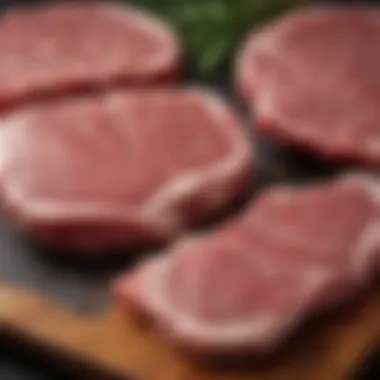
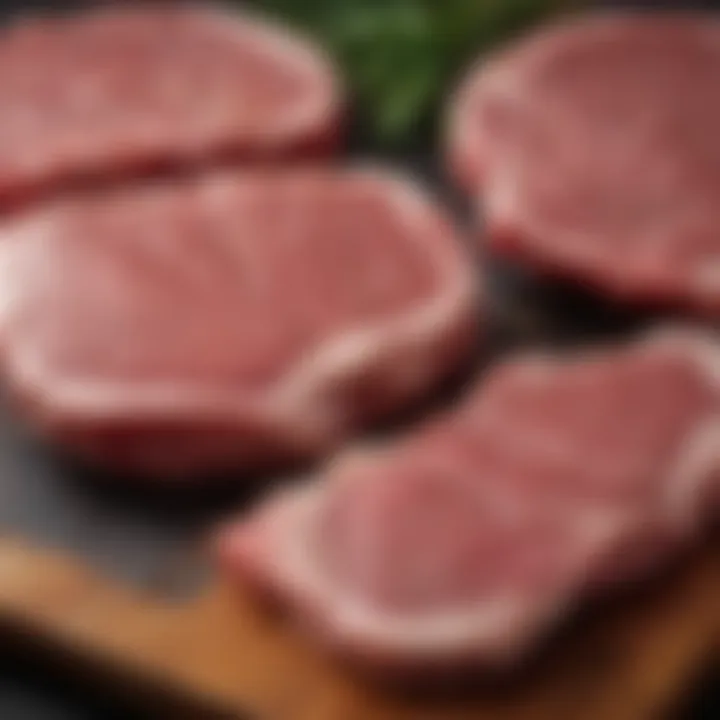
The surface area exposure of meat correlates with thawing efficiency. When more surface area is exposed, it can absorb heat from the thawing surface more effectively. This means that cuts with larger surface areas will thaw faster than those with less exposure.
For example, a split chicken breast thaws more quickly than a whole chicken despite their similar weight. The larger surface area allows heat to penetrate faster, making this an important factor to remember. Meat thawing boards often come with features designed to increase surface exposure, thus expediting the process and improving food safety.
Initial temperature
The initial temperature of meat at the point of thawing plays a crucial role in how quickly it will reach a safe cooking temperature. Starting with meat that is closer to room temperature will reduce thawing time considerably compared to meat that was recently taken from a deep freezer. This factor is particularly relevant if the meat is left out for an extended period, which may not be advisable due to safety protocols.
Understanding the initial temperature at which the meat is being thawed helps in planning the thawing process. It can determine how long the meat should remain on the thawing board and whether any additional adjustments are necessary.
Types of Meat Thawing Boards
Understanding the different types of meat thawing boards is essential for anyone who prepares meat in various kitchen settings. Each type has its own unique features that can enhance the thawing process, improve hygiene, and contribute to overall food safety. Key elements to consider include the material composition and the design features of these boards. Choosing the right type can make cooking more efficient and safe.
Material Composition
Plastic vs. Metal
When comparing plastic and metal thawing boards, one can note that each material has advantages. Plastic boards are often lightweight and easier to handle. They are popular for everyday use. On the other hand, metal thawing boards, such as those made from aluminum, are favored for their superior heat conductivity. This means that metal options can thaw meat more quickly than plastic. However, metal may be prone to scratching and can retain odors if not cleaned properly. It is crucial to consider these factors when choosing between plastic and metal.
Non-stick surfaces
Non-stick surfaces are another important characteristic in thawing boards. They make it easier to clean up after use. Food does not cling to non-stick materials, which helps maintain hygiene. While some may prefer non-stick coatings for their ease of cleaning, one should also consider the durability of these surfaces. Over time, non-stick finishes may wear off. This wear can lead to the need for replacement or concern over chemical leaching. Overall, non-stick surfaces are beneficial but should be evaluated carefully for long-term use.
Sustainability considerations
Sustainability is increasingly important in product choices. Many consumers look for thawing boards made from eco-friendly materials. This can reduce environmental impact. For example, bamboo boards are a sustainable option. They are biodegradable and can be long-lasting with proper care. However, one must also think about the sourcing and quality of such materials. Not all sustainable options are practical for kitchen use. Therefore, consumers should assess the balance between sustainability and functionality.
Design Features
Heat conduction properties
The heat conduction properties of a thawing board can significantly affect thawing time and efficiency. Metal boards tend to excel in this area, allowing for faster heat transfer. This can be crucial when time is a factor in meal preparation. In contrast, plastic boards do not conduct heat as well, which may extend thawing times. Understanding these properties can help in selecting the right board for specific needs.
Drainage systems
Drainage systems are essential in maintaining hygiene during the thawing process. Boards with integrated drainage can prevent water accumulation, which reduces the risk of bacterial growth. This feature is particularly important when thawing large cuts of meat. On the other hand, boards without drainage systems require more attentive cleaning to avoid hygiene issues. Choosing a thawing board with a good drainage design can help in maintaining food safety.
Ergonomic considerations
Ergonomic considerations play a role in user experience. Boards designed for comfort and ease of use can make a significant difference in food preparation. Features such as raised edges or grips can enhance usability. While these might seem minor, they contribute to a smoother cooking experience. It is beneficial to find thawing boards that combine functionality with comfort to improve the overall cooking process.
Practical Applications of Meat Thawing Boards
The importance of meat thawing boards lies in their ability to optimize the process of defrosting meat safely and effectively. Thawing boards serve as specialized tools designed to facilitate the even thawing of meat, minimizing the potential risk of bacterial growth. Proper thawing is crucial for food safety and quality. The application of thawing boards is relevant across various settings, and understanding these applications can greatly benefit culinary practices.
Utilizing Thawing Boards in Different Kitchen Settings
Home kitchens
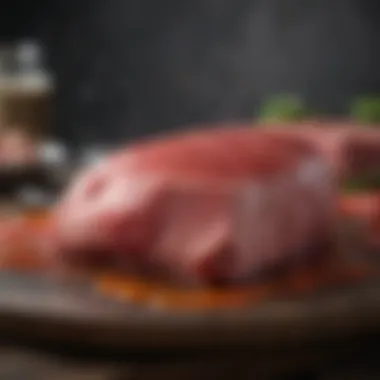
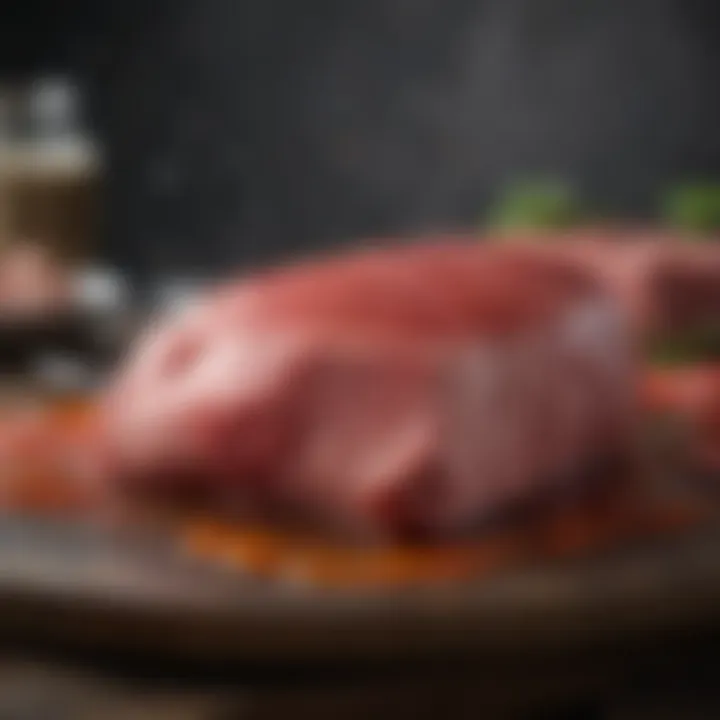
In home kitchens, thawing boards offer a practical solution for families. They allow users to thaw meat quickly without compromising safety. Many home cooks appreciate the convenience and efficiency these boards bring. A key characteristic is their ease of use; they can be placed directly on countertops without taking much space. One unique feature is the ability to thaw different meats at the same time, as many thawing boards are designed with varied sizes. However, a disadvantage may include the initial cost compared to traditional with other methods.
Commercial kitchens
Commercial kitchens benefit significantly from using thawing boards. They are essential for operations that handle large quantities of meat regularly. The need for efficiency is paramount in such environments, making thawing boards a beneficial choice for keeping up with demand. A notable feature is the durability of materials used for these boards; they can withstand the rigors of a busy kitchen. However, depending on the type of thawing board used, maintenance can be more involved, requiring proper cleaning protocols to maintain hygiene standards.
Catering services
Catering services require flexibility and speed in thawing processes. Thawing boards play a critical role in these settings, especially when preparing for large events. The key characteristic here is the mobility of many thawing boards, which can be easily transported to various locations. They allow caterers to manage their time effectively, ensuring that meat is thawed properly before cooking. On the downside, the need for immediate access to proper cleaning stations is crucial in catering, as ensuring hygiene in moving services may sometimes pose challenges.
Comparative Analysis with Other Thawing Methods
Microwave thawing
Microwave thawing is often considered for its quick results. The speed here is its primary advantage, allowing users to thaw meat in minutes. However, this method has a significant drawback: it can lead to uneven thawing. As a result, parts of the meat may begin to cook while others still remain frozen, impacting overall quality.
Water immersion
Water immersion is another popular method. It allows for faster thawing compared to refrigerator thawing but requires care to prevent food safety issues. The main feature of this method is that it can be done while keeping meat sealed in a bag to prevent contamination. Yet, users must keep an eye on the temperature of the water to avoid going beyond safe zones, which can be labor-intensive.
Refrigerator thawing
Using the refrigerator for thawing is the most recommended for food safety. This method is slow but minimizes bacterial growth due to the cool environment. A key characteristic of refrigerator thawing is the consistent temperature, which ensures that meat remains at a safe level throughout the process. However, the major disadvantage is the time required; large cuts can take several hours or even days to thaw fully.
Ultimately, while all these methods have their respective merits and drawbacks, thawing boards stand out for their balance of speed and safety.
Hygiene and Safety Considerations
The emphasis on hygiene and safety in the kitchen extends well beyond cooking. When it comes to thawing meat, maintaining proper cleanliness and preventing contamination is critically important. Thawing meat improperly can lead to the growth of harmful bacteria, increasing the risk of foodborne illness. Meat thawing boards are designed not only for efficient thawing but also with an eye toward safety and hygiene protocols. Understanding the best practices in this regard is essential for anyone who handles food.
Cleaning and Sanity Practices for Thawing Boards
Cleaning a thawing board is vital. After each use, it is crucial to wash these boards with hot, soapy water to remove any residual proteins or juices that may harbor bacteria. A clean thawing board helps to ensure that no harmful microbes remain on the surface.
Furthermore, sanitizing the board after cleaning can reduce the risk of bacterial survival. A solution of one tablespoon of unscented liquid chlorine bleach mixed with one gallon of water can effectively sanitize the surface. Alternatively, commercial sanitizing sprays are available, though it is advisable to check for food safety ratings.
The frequency of cleaning should increase especially when it is used for different types of meats. Given the different levels of risk associated with various meats, extra attention should be paid to boards used for poultry and ground meats. Using separate boards for different types of meat is a common method to enhance hygiene practices in the kitchen.
Preventing Cross-Contamination
Storage solutions
Effective storage solutions for thawing boards can greatly minimize risks associated with cross-contamination. Storing the thawing boards in a dedicated area, preferably in a clean and dry space, can help prevent them from coming into contact with contaminated surfaces. Using clear storage containers allows for easier visibility and can help ensure that the thawing boards are kept apart from areas where raw meats may be stored.
A key characteristic of these storage solutions is that they are typically made from materials that are easy to clean and maintain. This makes them a popular choice, especially in environments where kitchen space is limited. Storage solutions with lids can also shield boards from airborne contaminants. The unique feature here is the ability to stack these containers, saving valuable space in the kitchen while ensuring the thawing boards are protected.
Usage best practices
Implementing best practices during the usage of thawing boards contributes significantly to food safety. One critical aspect to consider is the timing; thawing meat should ideally be done close to cooking time. If the thawing process takes too long, it opens a window for bacteria to multiply.
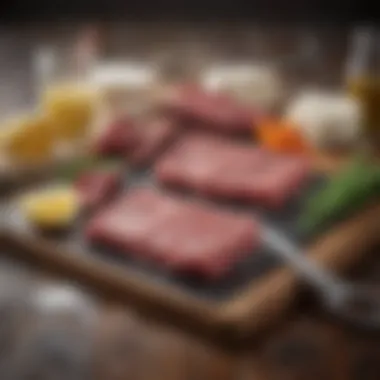
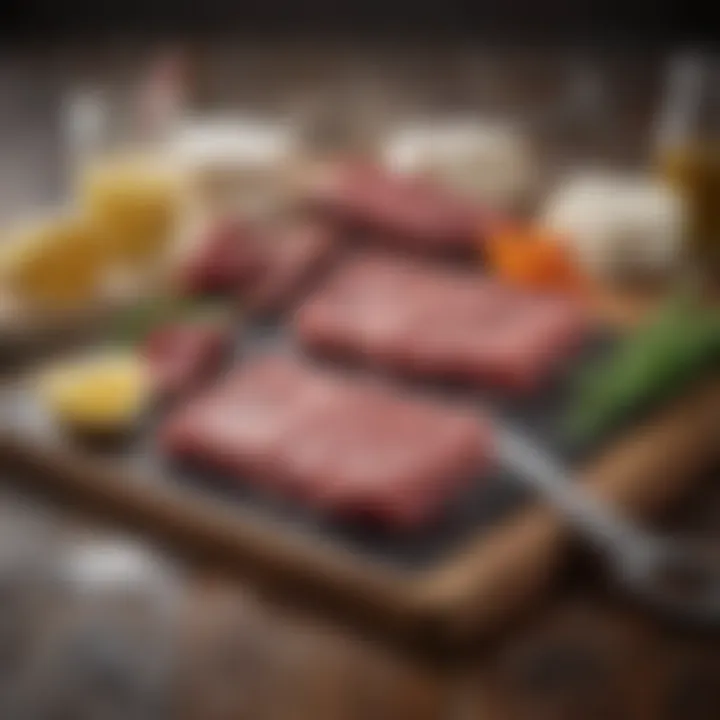
A beneficial aspect of following recommended usage practices is strong adherence to food safety guidelines, which fosters a safer cooking environment. Organizing thawing tasks so that meats are the last items prepared before cooking can help minimize the time they spend in the danger zone of temperatures, which is between 40°F and 140°F.
Using separate utensils with each board further prevents cross-contamination. This specific feature of best practices teaches users to regard how tools interact with raw meat, fostering an understanding crucial to food safety in the kitchen.
Cooking isn't just art; it requires careful science, especially when safely handling food.
All these aspects surrounding hygiene and safety considerations when using meat thawing boards are interconnected. Awareness and implementation of these practices can enhance the general safety in the kitchen and ensure that the culinary experience remains enjoyable.
The Future of Thawing Technology
The landscape of kitchen tools is ever-evolving, with innovations that promise to enhance efficiency and safety in food preparation. The future of thawing technology is crucial in this progression, as it addresses a fundamental aspect of cooking - the thawing of meat. As culinary enthusiasts become increasingly aware of food safety, the demand for smarter, more efficient thawing solutions rises. Thawing boards represent just one element of this technological evolution, but they play a significant role in addressing issues related to time and safety.
Innovations in Kitchen Tools
Smart thawing systems
Smart thawing systems integrate technology to optimize the meat thawing process. They often utilize advanced temperature control mechanisms which ensure that meat is thawed at a safe temperature, minimizing bacterial growth. This specific aspect contributes to safety, making it an important focus in the future of kitchen technology.
A key characteristic of most smart thawing systems is their ability to monitor the right thawing conditions automatically. Rather than relying on traditional methods which may lead to uneven thawing, these systems provide a consistent and safe environment. This is a beneficial choice because it reduces risks associated with undercooked or improperly thawed meat.
One unique feature of various smart thawing systems is their integration with mobile applications. Users can track thawing progress and configure settings remotely, adjusting as needed. These advantages show why smart thawing systems are attracting attention, but they are not without disadvantages. Potential downsides include higher costs and dependency on electricity or batteries.
User feedback mechanisms
User feedback mechanisms are becoming an integral part of kitchen equipment development, including thawing systems. They allow users to provide insights based on their experiences, which can greatly influence product improvements. This feedback contributes to a more user-centered design approach, leading to real-world solutions that meet the needs of culinary experts and enthusiasts alike.
A primary advantage of implementing user feedback is the enhancement of product functionality. For thawing boards, incorporating user insights can refine aspects such as ease of use and effectiveness. Not only does this make these tools more user-friendly, but it can also help manufacturers prioritize features that are most beneficial for consumers.
Some unique features of user feedback mechanisms include user rating systems and direct suggestions for improvements. These aspects can help manufacturers create tools that align closely with consumer expectations. However, challenges include gathering reliable feedback and addressing diverse consumer preferences, making it difficult to cater to all users effectively.
Consumer Trends and Preferences
Understanding consumer trends is crucial for any innovation's success in the kitchen. As preferences shift, manufacturers must adapt to meet new demands. The contemporary consumer is increasingly health-conscious, looking for tools that support food safety and minimize preparation time.
Among food lovers, there is a growing preference for tools that offer convenience. Thawing boards that integrate with technology and allow for quicker processing times are likely to see increased popularity. Additionally, sustainability factors are becoming more prominent, influencing choice in materials used in thawing systems.
"Innovation is not just about technology; it's about understanding the needs of the consumer and meeting them effectively."
By focusing on these principles, the future of kitchen thawing technologies looks promising.
The End
Summarizing Key Insights
In this article, we have explored various aspects of meat thawing boards. Key insights include:
- Efficiency: Thawing boards significantly reduce thawing time compared to traditional methods. The materials used in their construction enhance heat conduction, allowing meat to thaw more evenly and quickly.
- Safety: Safe thawing minimizes the risk of cross-contamination and foodborne illnesses. By using thawing boards, one can maintain better control over the thawing environment compared to methods like leaving meat at room temperature.
- Versatility: These boards can be used in various kitchen settings, from home kitchens to professional establishments, demonstrating their adaptability and broad application.
Moreover, the innovations in thawing technology indicate a shift toward smarter kitchen tools designed to enhance convenience while prioritizing safety.
Final Thoughts on Safe Thawing Practices
Safe thawing practices are fundamental for anyone handling meat. Here are several considerations to keep in mind:
- Always thaw meat in the refrigerator when possible. If that is not feasible, make sure to use a thawing board to avoid temperature abuses.
- Never leave meat at room temperature for extended periods, as this can encourage bacterial growth.
- Regular cleaning of thawing boards is essential to prevent cross-contamination. Use hot, soapy water, followed by thorough drying after each use.







